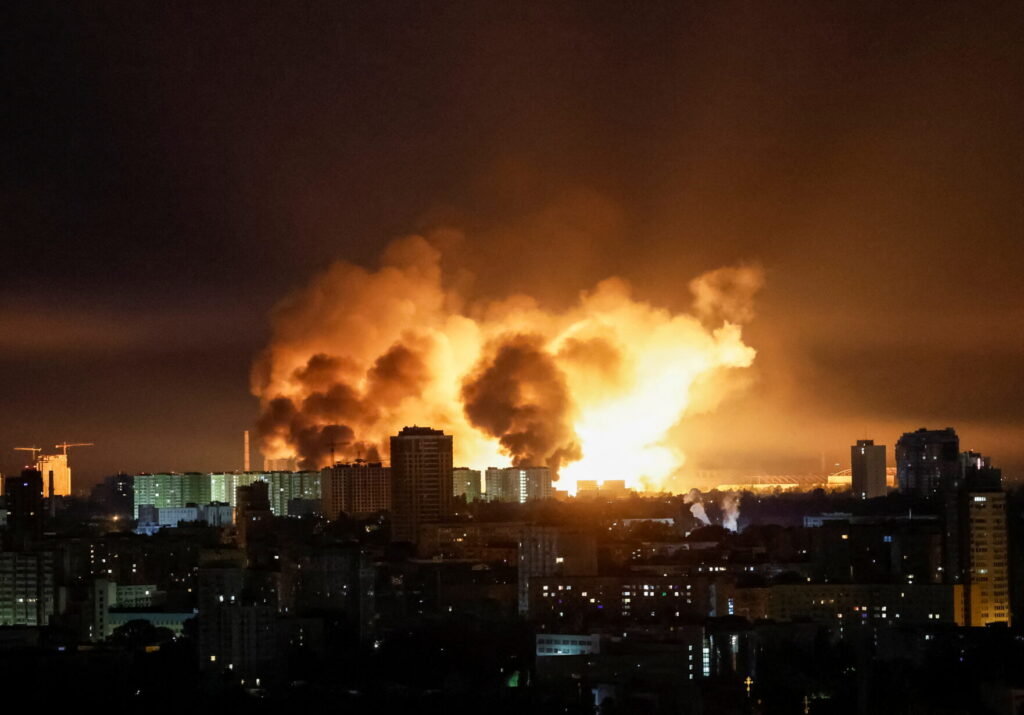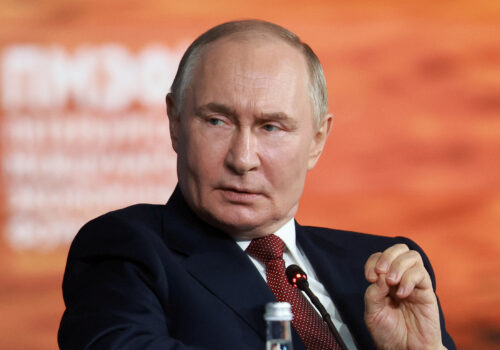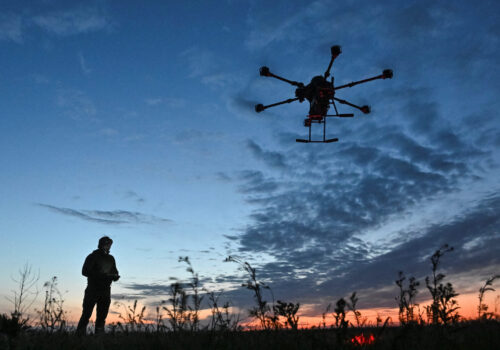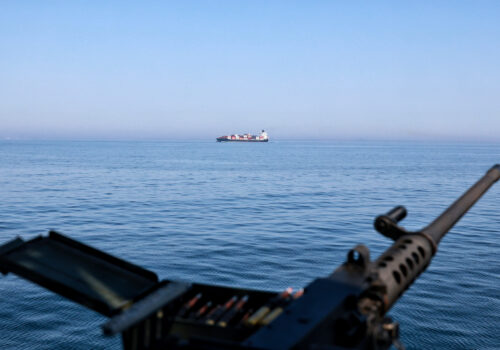Russia launched the largest aerial attack of the entire Ukraine invasion in the early hours of June 29, according to Ukrainian officials. The Russians dispatched a total of 537 aerial weapons in the overnight bombardment, including 477 drones and decoys along with at least sixty missiles, Ukrainian Air Force spokesman Yuriy Ihnat told the Associated Press.
This latest attack is part of a broader escalation in Russia’s air war that has seen the number of drones fired at Ukraine more than double during the six months since Donald Trump returned to the White House. The dramatic increase in Russian airstrikes has led to a sharp rise in Ukrainian civilian casualties in recent months, and is now threatening to overwhelm the country’s limited air defense capabilities.
Russia’s air offensive is not new, of course. The Kremlin has been bombing Ukraine’s critical infrastructure and civilian population since the onset of the full-scale invasion more than three years ago. Recently, however, technological advances and increased industrial output have made it possible for Moscow to significantly expand the bombardment of Ukrainian cities. The Kremlin’s goal is to make life unbearable for Ukrainian civilians and increase the pressure on the country’s political leadership as Russia seeks to secure Kyiv’s capitulation.
Stay updated
As the world watches the Russian invasion of Ukraine unfold, UkraineAlert delivers the best Atlantic Council expert insight and analysis on Ukraine twice a week directly to your inbox.
The biggest change during 2025 has been in the sheer scale of Russia’s aerial attacks. In late 2024, Moscow was launching around two thousand drones per month at Ukrainian cities. That figure has now risen to more than four thousand. While a typical attack may earlier have involved dozens of drones, it is now commonplace for Russia to launch hundreds of drones in a single night. Inevitably, this increase in volume means more and more drones are reaching their targets.
This has been made possible by massively expanded drone production inside Russia. During the first year of the full-scale invasion, the Russians initially relied on Iran to supply the bulk of the long-range drones used in attacks on Ukrainian cities. More recently, Moscow has acquired the relevant technology from Tehran and begun producing drones domestically.
With dependence on Iran now reduced to a minimum, Russia’s expanding drone production is in part thanks to backing from the Kremlin’s other authoritarian allies. Ukraine has accused China of supporting Russia’s efforts to ramp up domestic drone output and claims Beijing is providing Moscow with a wide range of vital technical components. Recent reports also indicate that North Korea is poised to send tens of thousands of workers to produce drones at industrial facilities in eastern Russia.
Russia’s increasingly deadly drone attacks are not only due to growing numbers. Russian drones are also evolving to become faster and more explosive, with some of the latest models featuring video cameras and incorporating AI technologies. The current generation of drones tend to attack from higher altitudes, making them significantly more difficult for Ukrainian air defense crews to intercept.
Meanwhile, Russian drone warfare specialists continue to develop more effective tactics. This includes coordinated attacks involving drones together with cruise missiles and ballistic missiles to overload Ukraine’s air defenses. Russia is also now incorporating so-called wolf pack tactics, with drones approaching a target from a range of different directions before striking virtually simultaneously. This has proved far more effective than launching wave after wave of drone attacks.
Eurasia Center events

Russia’s increasingly deadly drone campaign is having a demoralizing impact on the population throughout Ukraine. Addressing this challenge is now one of the most urgent and complex tasks facing the Ukrainian military.
The most obvious solution would be to destroy Russian drones before they can be launched, either at production sites or storage facilities. Russia is well aware of this and has moved production lines far away from Ukraine. As Russian drones do not require traditional airfields, attacks on launch sites are unlikely to have a significant impact.
At present, Ukraine’s anti-drone defenses include a combination of heavy machine guns and traditional anti-aircraft artillery. This approach proved fairly effective during the first few years of the war, but ground crews are now increasingly unable to cope with the scale of Russia’s attacks and the sophistication of Moscow’s most recent drone models. Missile defense systems and fighter jets have a better chance of intercepting Russia’s upgraded drone fleet, but this is a very expensive approach that risks exhausting Ukraine’s air defenses and leaving the country vulnerable to missile strikes.
As the destruction of residential districts across Ukraine reaches unprecedented levels, it is clear that the Ukrainian military needs to adopt new approaches to address the growing drone menace. The most cost-effective solution would be to produce interceptor drones capable of protecting Ukrainian cities. This process is already underway but must be urgently scaled up to reflect the size of the task ahead.
There is no time to waste. Ukraine’s dynamic defense tech sector is developing a range of potentially effective interceptor drone models, but large-scale production is crucial. This will require decisive measures from the Ukrainian authorities to identify the most effective solutions and provide the necessary backing in a timely fashion. Kyiv’s partners can also contribute to this process by supplying interceptor drones and financing the manufacture of domestic models.
In addition to interceptor drones, some analysts see promise in the expanded use of helicopters and perhaps even propeller planes to shoot down Russian drones. Propeller planes may be particularly well-suited to this task, offering an economically viable alternative to the use of jet fighters while operating at speeds closer to the drones they aim to intercept. A Ukrainian F-16 pilot and his plane were lost while trying to destroy incoming Russian drones and missiles on June 29, underlining the dangers of such operations.
Russia’s escalating drone war is the latest chapter in an invasion that has been shaped by rapid technological development. Ukraine can expect recent Russian trends to continue, with more massive aerial attacks featuring deadlier drones. If they wish to prevent a collapse in Ukrainian morale, officials in Kyiv must rapidly come up with their own tech solutions in quantities capable of blunting the threat posed by Putin’s expanding drone fleet.
Mykola Bielieskov is a research fellow at the National Institute for Strategic Studies and a senior analyst at Ukrainian NGO “Come Back Alive.” The views expressed in this article are the author’s personal position and do not reflect the opinions or views of NISS or Come Back Alive.
Further reading
The views expressed in UkraineAlert are solely those of the authors and do not necessarily reflect the views of the Atlantic Council, its staff, or its supporters.

The Eurasia Center’s mission is to enhance transatlantic cooperation in promoting stability, democratic values, and prosperity in Eurasia, from Eastern Europe and Turkey in the West to the Caucasus, Russia, and Central Asia in the East.
Follow us on social media
and support our work
Image: An explosion of a drone lights up the sky over the city during a Russian drone strike, amid Russia's attack on Ukraine, in Kyiv, Ukraine. May 24, 2025. (REUTERS/Gleb Garanich)





